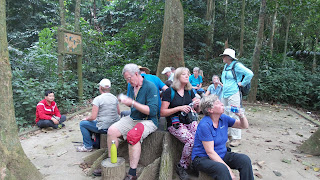Ngoc Son Temple is situated on Hoan Kiem lake, in the heart of
Hanoi city. The temple was built on Ngoc or the Jade Islet. The temple is dedicated
to Van Xuong who is considered as the brightest star in Vietnamese literature,
and Tran Hung Dao, the national hero who led Vietnamese army to defeat Mongol
aggressors in the 13th century.
Nguyen Van Sieu, Hanoi, scholar, contributed his effort to
restore and extend the temple by 1860s. By the entrance of the temple is a
large pen-shaped tower with 3 Chinese characters on it, Ta Thanh Thien or Write
on the blue sky, that imply the height of a genuine and righteous person’s
strength and will.
The temple open from 7 AM – 18PM daily. Please wear long
trousers when visiting the temple. Move from main street of Dinh Tien Hoang you
pass Thap But tower, then reach The Huc red bridge (the bridge receives morning
sun beam), get though entrance gate to Ngoc Son Temple. Stop to pray in the
yard by Tran Ba Pavilion. Next tothe temple it is a small house where Hanoi preserves
a huge sort of tortoise that still live in Hoan Kiem lake.
Ảnh: internet
Ngoc Son temple is one of the main attraction in the tour program named Hanoi city tour one day. The temple stay in the heart of Hanoi and by the edge of the bustling old quarter. Get there and walk around you can take nice photos or buy ticket for electrical car to explore the old Hanoi.
Selected by Vietindo Travel






































































